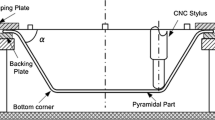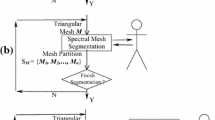Abstract
Automatic mesh generation is one of the most important parts in CIMS (Computer Integrated Manufacturing System). A method based on mesh grading propagation which automatically produces a triangular mesh in a multiply connected planar region is presented in this paper. The method decomposes the planar region into convex subregions, using algorithms which run in linear time. For every subregion, an algorithm is used to generate shrinking polygons according to boundary gradings and form Delaunay triangulation between two adjacent shrinking polygons, both in linear time. It automatically propagates boundary gradings into the interior of the region and produces satisfactory quasi-uniform mesh.
Similar content being viewed by others
References
Haber Ret al. A general two-dimensional, graphical finite element preprocessor utilizing discrete transfinite mappings.Int’l J. Numer. Methods Eng., 1981, 17(7): 1015–1044.
Yerry M A, Shephard M S. A modified quadtree approach to finite element mesh generation.IEEE CG&A, 1983, 3(1): 39–46.
Baehmann P Let al. Robust, geometrically based, automatic two-dimensional mesh generation.Int’l J. Numer. Methods Eng., 1987, 24(6): 1043–1078.
Sadek E A. A scheme for the automatic generation of triangular finite elements.Int’l J. Numer Methods Eng., 1980, 15(12): 1813–1822.
Deljouie-Rakhshandeh K. An approach to the generation of triangular grids possessing few obtuse triangles.Int.l J. Numer. Methods Eng., 1990, 29(6): 1299–1321.
Jin H, Wiberg N. Two-dimensional mesh generation, adaptive remeshing and refinement.Int’l J. Numer. Methods Eng., 1990, 29(7): 1501–1526.
Zhu J Zet al. A new approach to the development of automatic quadrilateral mesh generation.Int.’l J. Numer. Methods Eng., 1991, 32(4): 849–866.
Shaw R D, Pitchen R G. Modifications to the Suhara-Fukuda method of network generation.Int’l J. Numer. Methods Eng., 1978, 12(1): 93–99.
Cavendish J C. Automatic triangulation of arbitrary planar domains for the finite element method.Int’l J. Numer. Methods Eng., 1974, 8(4): 679–696.
Sapidis N, Perucchio R. Delaunay triangulation of arbitrarily shaped planar domains.Computer Aided Geometric Design, 1991, 8(6): 421–437.
Joe B. Delaunay triangular meshes in convex polygons.SIAM J Scientific and Statistical Computing, 1986, 7(2): 514–539.
Bhatia R P, Lawrence K L. Two-dimensional finite element mesh generation based on stripwise automatic triangulation.Computers & Structures, 1990, 36(2): 309–319.
Blacker T D, Stephenson M B. Paving: A new approach to automated quadrilateral mesh generation.Int’l J. Numer. Methods Eng., 1991, 32(4): 811–847.
Joe B, Simpson R B. Triangular meshes for regions of complicated shape.Int’l J. Numer. Methods Eng., 1986, 23(5): 751–778.
Sezer L, Zeid I. Automatic quadrilateral/triangular free-form mesh generation for planar regions.Int’l J. Numer. Methods Eng., 1991, 32(7): 1441–1483.
Talbert J A, Parkinson A R. Development of an automatic, two-dimensional finite element mesh generator using quadrilateral elements and bezier curve boundary definition.Int’l J. Numer. Methods Eng., 1990, 29(7): 1551–1567.
Parthasarathy V N, Kodiyalam S. A constrained optimization approach to finite element mesh smoothing.Finite Elements in Analysis and Design, 1991, 9(4): 309–320.
Lee D T, Schachter B J. Two algorithms for constructing a Delaunay triangulation.Int. J. Computer and Information Sciences, 1980, 9(3): 219–242.
Bykat B. Automatic generation of triangular grid: I—subdivision of a general polygon into convex subregions. II—triangulation of convex polygons.Int’l J. Numer. Methods Eng., 1976, 10(6): 1329–1342.
Author information
Authors and Affiliations
Additional information
Min Weidong is a Lecturer in the Department of Computer Science and Technology, Tsinghua University. He received his B.E., M.E. and Ph.D. degrees from Tsinghua University in 1989, 1991 and 1995, respectively. His research interests include computational geometry, computer graphics and computer aided design. He is currently a postdoctor in the University of alberta in Canada (Email: weidong@cs.ualberta.ca).
Tang Zesheng is a Professor of Department of Computer Science and Technology, Tsinghua University. From 1985 to 1986, he visited The University of Michigan and worked in XEROX Palo Alto Research Center in California. His current research interests include scienctific visualization and computational geometry. He is the Vice Chairman of CAD and Computer Graphics Society of China Computer Federation, and a member of the Computer Engineering and Application Society of China Electronic Institute.
Zhang Zhengming is an Assistant Lecturer. He obtained his B.E. and M.E. degrees from Tsinghua University in 1990 and 1993, respectively. His current research area is structure analysis of nuclear reactor.
Zhou Yu is a Associate Professor. He obtained his B.E. degree from Peking University in 1982 and his M.E. degree from Tsinghua University in 1988. his research area is structure analysis of nuclear reactor.
Wang Minzhi is a Lecturer. She received her B.E. and M.E. degrees from Tsinghua University in 1988 and 1993, respectively. Her current research area is structure analysis of nuclear reactor.
Rights and permissions
About this article
Cite this article
Min, W., Tang, Z., Zhang, Z. et al. A new approach to fully automatic mesh generation. J. of Comput. Sci. & Technol. 10, 491–508 (1995). https://doi.org/10.1007/BF02943508
Received:
Issue Date:
DOI: https://doi.org/10.1007/BF02943508




